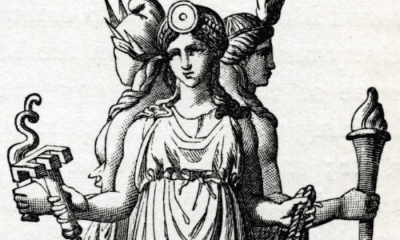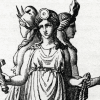Greek
What Did Aphrodite Look Like?
Aphrodite was the goddess of beauty, but what did that mean to the people of the Greco-Roman world?
The name Aphrodite often brings to mind very specific images. From ancient statues of the goddess with draped garments to Botticelli’s Birth of Venus, Aphrodite was shown as an ideal figure of beauty and attractiveness.
It might be surprising to learn that Greek writers, however, gave very little in the way of detail when describing the goddess of beauty. Only a handful of written sources exist that describe the way Aphrodite looked, and even those give little beyond a vague sense of loveliness.
This was not unique to Aphrodite. On the whole, Greek writers gave few physical descriptions of the gods or of men and were more likely to dwell on the hideous.
This was in part due to style and partially due to the understood conventions of beauty that meant no specific descriptions were needed. However, the lack of textual descriptors also gave artists the freedom to interpret Aphrodite’s great beauty for themselves.
Descriptions and Images of Aphrodite
Classical literature offers few physical descriptions of any of the gods, but a handful of writers discussed Aphrodite’s beauty in detail.
Homer, for example, said that the goddess could be recognized by her shining eyes and “desirable breasts.” Other writers gave her the epithet “Smile-Loving,” indicating that she often had a happy expression.
More often, writers described Aphrodite’s beauty through her clothing. She wore perfumed and silken garments, a crown of gold or flowers in her hair, and had expensive jewelry covering her body.
Because writers rarely described the appearances of the gods in any detail, most of what we know about Aphrodite’s looks must be drawn from the art of the period.
Again, the representations leave much room for interpretation. The one aspect they have in common is that, fittingly, Aphrodite was shown as beautiful.
This usually meant that she had feminine curves, which were often accentuated by closely-draped clothing. When she was dressed it was often only partially, but the goddess was just as often shown in the nude.
She usually had long hair that was left at least partially down, in contrast to the more demure, covered hair of matronly and domestic goddesses. A favorite subject of classical artists was the emergence of Aphrodite from the sea, in which she was sometimes shown wringing the water out of her long hair.
Painted images of Aphrodite often follow the descriptions of various writers and show the goddess adorned with necklaces, earrings, and bracelets. Her clothing in these images is often detailed with delicate patterns and, in the case of later frescos, rich colors.
Sculptors had more freedom than painters to imagine the goddess in different poses and situations. Often these poses emphasized her feminine shape and attractiveness to the male gaze.
My Modern Interpretation
Images of Aphrodite have persisted through time, always reflecting the contemporary ideals of beauty.
Greek artists imagined all the gods as paragons of physical perfection, but Aphrodite was thought to be particularly ideal. As the goddess of beauty, she represented the most desirable female form possible.
Because the gods were perfect representations of human bodies, writers saw little need to detail their physical attributes. The beauty of the gods, particularly Aphrodite, could be understood without detail.
The gods could also change their forms. They often changed their appearances to suit their purposes.
This shape-shifting also allowed artists to portray the gods in a way that reflected the physical idea of their own time and place. Aphrodite could have dark hair in one place and be blonde in another.
Thus, our modern interpretation of Aphrodite has been filtered through the ideals of female beauty from not only Greece and Rome, but long after as well. Medieval artists gave her a high forehead and Renaissance painters showed her with flowing blonde hair because those were the ideals of their times.
The written descriptions of Aphrodite were open-ended enough to allow artists to show her in a way they thought was beautiful for centuries. While later artists were influenced by the paintings and sculptures of Rome and Greece, they had the license to show the goddess of beauty in a way that made sense within their own cultures.
This tradition continues in art today. Modern depictions of Aphrodite show a wider variety of skin tones and body types to reflect the artists’ own views on beauty and desire.
The goddess of beauty can be recognized across cultures, however, because she is shown as desirable. Even when precise views on beauty have changed, it is possible to recognize the often seductive poses of Aphrodite with no other attributes or symbols attached.
Some aspects of Aphrodite’s image remained constant over time, influenced by the ideals of Greece and Rome. She was shown then and for many centuries later with light skin, full hair, round breasts, and full hips.
Although the details changed, these standards of beauty persisted throughout much of European history. In a more diverse and globalized world, however, modern interpretations of Aphrodite show a greater variety.
In Summary
Like most gods and goddesses, Aphrodite was never described in detail by Greek writers.
The Greek understood the gods to exist in ideal and perfect forms, so even for the goddess of beauty little definite detail was needed to convey the intended image.
Most often, Aphrodite’s clothing and jewelry were described in greater detail than her body or facial features. The richness of her garments and adornments both enhanced her features and signalled her nobility.
The lack of written detail meant that artists were able to portray Aphrodite in a way they felt was beautiful. While these typically followed certain conventions, these conventions could vary between regions and time periods.
Aphrodite remained one of the most often-depicted Greco-Roman deities in art long after paganism ended in Europe. Her status as the most beautiful and desirable goddess of Olympus gave artists the license to depict their own versions of the most beautiful woman in existence.
Aphrodite/Venus was therefore shown with certain marks of beauty that had persisted from the ancient world, but also with the features and clothing considered ideal in the artists’ own times. She could be recognized not by a specific feature, but by her desirability.



